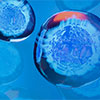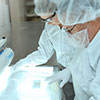chromatography+columns+HyClone+products+(Cytiva)
Catalog Number:
(10111-006)
Supplier:
Prosci
Description:
The protein encoded by TIAL1 is a member of a family of RNA-binding proteins and possesses nucleolytic activity against cytotoxic lymphocyte target cells. The gene product is a cytotoxic granule-associated protein and has been shown to bind specifically to poly (A) homopolymers and to fragment DNA in permeabilized target cells. It has been suggested that members of this protein family may be involved in the induction of apoptosis. One isoform contains a lysosome-targeting motif in its C-terminal auxiliary domain; however, alternative splicing results in a T-cluster DNA-binding isoform, differing at the C-terminus where a hydrophobic sequence replaces the lysosome-targeting motif.
Catalog Number:
(10102-836)
Supplier:
Prosci
Description:
G6PC hydrolyzes glucose-6-phosphate to glucose in the endoplasmic reticulum.It forms with the glucose-6-phosphate transporter (SLC37A4/G6PT) the complex responsible for glucose production through glycogenolysis and gluconeogenesis. Hence, it is the key enzyme in homeostatic regulation of blood glucose levels.Glucose-6-phosphatase is an integral membrane protein of the endoplasmic reticulum that catalyzes the hydrolysis of D-glucose 6-phosphate to D-glucose and orthophosphate. It is a key enzyme in glucose homeostasis, functioning in gluconeogenesis and glycogenolysis. Defects in the enzyme cause glycogen storage disease type I (von Gierke disease). Publication Note: This RefSeq record includes a subset of the publications that are available for this gene. Please see the Entrez Gene record to access additional publications.
Catalog Number:
(89358-998)
Supplier:
Genetex
Description:
ADP-ribosylation factor 5 (ARF5) is a member of the human ARF gene family. These genes encode small guanine nucleotide-binding proteins that stimulate the ADP-ribosyltransferase activity of cholera toxin and play a role in vesicular trafficking and as activators of phospholipase D. The gene products include 6 ARF proteins and 11 ARF-like proteins and constitute 1 family of the RAS superfamily. The ARF proteins are categorized as class I (ARF1, ARF2,and ARF3), class II (ARF4 and ARF5) and class III (ARF6). The members of each class share a common gene organization. The ARF5 gene spans approximately 3.2kb of genomic DNA and contains six exons and five introns. [provided by RefSeq]
Catalog Number:
(10102-550)
Supplier:
Prosci
Description:
CA8 was initially named CA-related protein because of sequence similarity to other known carbonic anhydrase genes. However, CA8 lacks carbonic anhydrase activity (i.e., the reversible hydration of carbon dioxide). CA8 continues to carry a carbonic anhydrase designation based on clear sequence identity to other members of the carbonic anhydrase gene family. The protein encoded by this gene was initially named CA-related protein because of sequence similarity to other known carbonic anhydrase genes. However, the gene product lacks carbonic anhydrase activity (i.e., the reversible hydration of carbon dioxide). The gene product continues to carry a carbonic anhydrase designation based on clear sequence identity to other members of the carbonic anhydrase gene family. The absence of CA8 gene transcription in the cerebellum of the lurcher mutant in mice with a neurologic defect suggests an important role for this acatalytic form.
Catalog Number:
(89358-322)
Supplier:
Genetex
Description:
This gene product mediates the attachment of erythroblasts to macrophages. This attachment promotes terminal maturation and enucleation of erythroblasts, presumably by suppressing apoptosis. This protein is an integral membrane protein with the N-terminus on the extracellular side and the C-terminus on the cytoplasmic side of the cell. Two immunologically related isoforms of erythroblast macrophage protein with apparent molecular weights of 33 kD and 36 kD were detected in macrophage membranes; this gene encodes the larger isoform. Multiple alternatively spliced transcript variants encoding distinct isoforms have been found for this gene, but the biological validity of some variants has not been determined. [provided by RefSeq]
Catalog Number:
(10108-684)
Supplier:
Prosci
Description:
CHGA is a member of the chromogranin/secretogranin family of neuroendocrine secretory proteins. It is found in secretory vesicles of neurons and endocrine cells. Its gene's product is a precursor to three biologically active peptides; vasostatin, pancreastatin, and parastatin. These peptides act as autocrine or paracrine negative modulators of the neuroendocrine system. Other peptides, including chromostatin, beta-granin, WE-14 and GE-25, are also derived from the full-length protein. However, biological activities for these molecules have not been shown.The protein encoded by this gene is a member of the chromogranin/secretogranin family of neuroendocrine secretory proteins. It is found in secretory vesicles of neurons and endocrine cells. This gene product is a precursor to three biologically active peptides; vasostatin, pancreastatin, and parastatin. These peptides act as autocrine or paracrine negative modulators of the neuroendocrine system. Other peptides, including chromostatin, beta-granin, WE-14 and GE-25, are also derived from the full-length protein. However, biological activities for these molecules have not been shown.
Catalog Number:
(10105-032)
Supplier:
Prosci
Description:
NFATC4 is a member of the nuclear factors of activated T cells DNA-binding transcription complex. This complex consists of at least two components: a preexisting cytosolic component that translocates to the nucleus upon T cell receptor (TCR) stimulation and an inducible nuclear component. Other members of this family of nuclear factors of activated T cells also participate in the formation of this complex. NFATC4 plays a role in the inducible expression of cytokine genes in T cells, especially in the induction of the IL-2 and IL-4.The product of this gene is a member of the nuclear factors of activated T cells DNA-binding transcription complex. This complex consists of at least two components: a preexisting cytosolic component that translocates to the nucleus upon T cell receptor (TCR) stimulation and an inducible nuclear component. Other members of this family of nuclear factors of activated T cells also participate in the formation of this complex. The product of this gene plays a role in the inducible expression of cytokine genes in T cells, especially in the induction of the IL-2 and IL-4.
Catalog Number:
(10104-072)
Supplier:
Prosci
Description:
KLC3 is a member of the kinesin light chain gene family. Kinesins are molecular motors involved in the transport of cargo along microtubules, and are composed of two kinesin heavy chain (KHC) and two kinesin light chain (KLC) molecules. KLCs are thought to typically be involved in binding cargo and regulating kinesin activity. In the rat, a protein similar to this gene product is expressed in post-meiotic spermatids, where it associates with structural components of sperm tails and mitochondria.This gene encodes a member of the kinesin light chain gene family. Kinesins are molecular motors involved in the transport of cargo along microtubules, and are composed of two kinesin heavy chain (KHC) and two kinesin light chain (KLC) molecules. KLCs are thought to typically be involved in binding cargo and regulating kinesin activity. In the rat, a protein similar to this gene product is expressed in post-meiotic spermatids, where it associates with structural components of sperm tails and mitochondria.
Catalog Number:
(CA602-4304)
Supplier:
Rockland Immunochemical
Description:
This product has been assayed against 1.0 µg of Cat IgG in a standard capture ELISA using ABTS (2,2’-azino-bis-[3-ethylbenthiazoline-6-sulfonic acid])
Catalog Number:
(CA607-4504)
Supplier:
Rockland Immunochemical
Description:
This product has been assayed against 1.0 µg of Hamster IgG in a standard capture ELISA using pNPP p-nitrophenyl phosphate as a substrate for 30 minutes at room temperature.
Catalog Number:
(10110-750)
Supplier:
Prosci
Description:
PRDX3 is a protein with antioxidant function and is localized in the mitochondrion. Expression of this gene product in E. coli deficient in the C22-subunit gene rescued resistance of the bacteria to alkylhydroperoxide. The human and mouse genes are highly conserved, and they map to the regions syntenic between mouse and human chromosomes. Sequence comparisons with recently cloned mammalian homologues suggest that these genes consist of a family that is responsible for regulation of cellular proliferation, differentiation, and antioxidant functions. This gene encodes a protein with antioxidant function and is localized in the mitochondrion. This gene shows significant nucleotide sequence similarity to the gene coding for the C22 subunit of Salmonella typhimurium alkylhydroperoxide reductase. Expression of this gene product in E. coli deficient in the C22-subunit gene rescued resistance of the bacteria to alkylhydroperoxide. The human and mouse genes are highly conserved, and they map to the regions syntenic between mouse and human chromosomes. Sequence comparisons with recently cloned mammalian homologues suggest that these genes consist of a family that is responsible for regulation of cellular proliferation, differentiation, and antioxidant functions. Two transcript variants encoding two different isoforms have been found for this gene.
Catalog Number:
(CA609-4631)
Supplier:
Rockland Immunochemical
Description:
This product has been assayed against 1.0 µg of Human IgG in a standard capture ELISA using Peroxidase Conjugated Streptavidin and ABTS (2,2’-azino-bis-[3-ethylbenthiazoline-6-sulfonic acid])
Catalog Number:
(CA610-4602)
Supplier:
Rockland Immunochemical
Description:
When choosing a secondary antibody product, consideration must be given to species and immunoglobulin specificity, conjugate type, fragment and chain specificity, level of cross-reactivity, and host-species source and fragment.
Catalog Number:
(10108-642)
Supplier:
Prosci
Description:
At present, eight distinct classes of the soluble cytoplasmic mammalian glutathione S-transferases have been identified: alpha, kappa, mu, omega, pi, sigma, theta and zeta. GSTM2 is a glutathione S-transferase that belongs to the mu class. The mu class of enzymes functions in the detoxification of electrophilic compounds, including carcinogens, therapeutic drugs, environmental toxins and products of oxidative stress, by conjugation with glutathione.Cytosolic and membrane-bound forms of glutathione S-transferase are encoded by two distinct supergene families. At present, eight distinct classes of the soluble cytoplasmic mammalian glutathione S-transferases have been identified: alpha, kappa, mu, omega, pi, sigma, theta and zeta. This gene encodes a glutathione S-transferase that belongs to the mu class. The mu class of enzymes functions in the detoxification of electrophilic compounds, including carcinogens, therapeutic drugs, environmental toxins and products of oxidative stress, by conjugation with glutathione. The genes encoding the mu class of enzymes are organized in a gene cluster on chromosome 1p13.3 and are known to be highly polymorphic. These genetic variations can change an individual's susceptibility to carcinogens and toxins as well as affect the toxicity and efficacy of certain drugs.
Catalog Number:
(CA606-4604)
Supplier:
Rockland Immunochemical
Description:
This product has been assayed against 1.0 µg of Guinea Pig IgG in a standard capture ELISA using Peroxidase Conjugated Streptavidin and ABTS (2,2’-azino-bis-[3-ethylbenthiazoline-6-sulfonic acid])
Catalog Number:
(CA610-4541)
Supplier:
Rockland Immunochemical
Description:
This product has been assayed against 1.0 µg of Mouse IgG in a standard capture ELISA using pNPP p-nitrophenyl phosphate as a substrate for 30 minutes at room temperature.
Inquire for Price
Stock for this item is limited, but may be available in a warehouse close to you. Please make sure that you are logged in to the site so that available stock can be displayed. If the
Stock for this item is limited, but may be available in a warehouse close to you. Please make sure that you are logged in to the site so that available stock can be displayed. If the
You must log in to order restricted items. We request that you provide the required business documentation to purchase this product for the first time.
To order chemicals, medical devices, or other restricted products please provide identification that includes your business name and shipping address via email CMD_NA@vwr.com or fax 484.881.5997 referencing your VWR account number . Acceptable forms of identification are:
-Additional Documentation May be needed to purchase this item. A VWR representative will contact you if needed.
This product has been blocked by your organization. Please contact your purchasing department for more information.
The original product is no longer available. The replacement shown is available.
This product is currently unavailable but limited stock may be available in our extended warehouse network. Please call 1-800-932-5000 and a VWR Customer Service Representative will help you.
|
|||||||||


































